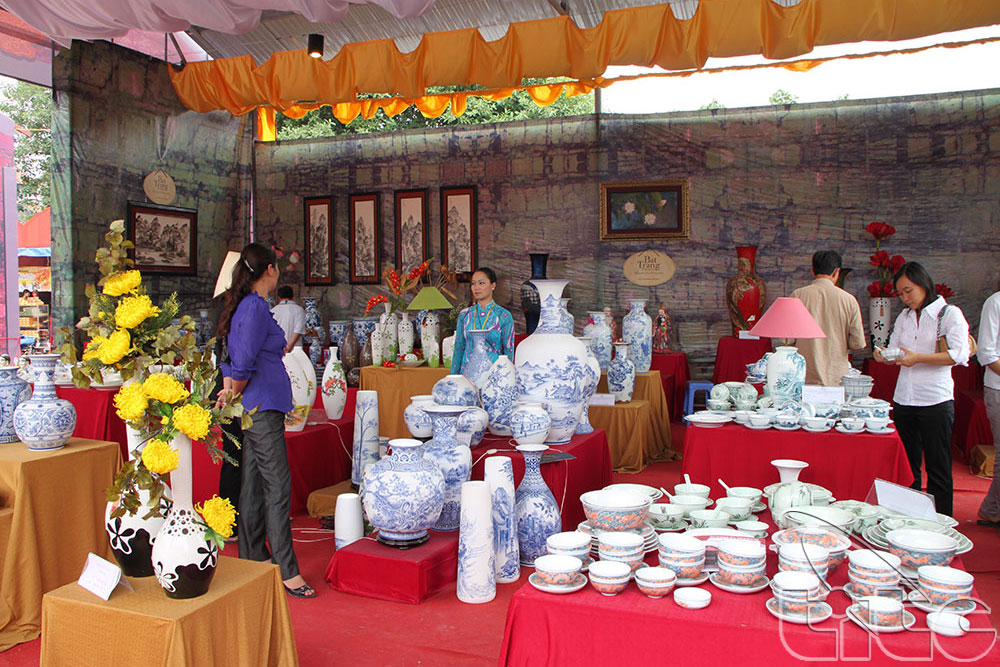A few years ago, visitors to Bat Trang pottery village in Ha Noi’s Gia Lam district would be greeted by a thick layer of smoke emitted from the kilns.

Over the last ten years, Bat Trang has worked to reduce its negative impact on the environment by employing cleaner manufacturing methods. Through these continued efforts, Bat Trang is gradually changing to become a model of a green, clean, and beautiful handicraft village, Hoang Lan reports.
Environmental impact
As one of Hanoi’s remaining traditional handicraft villages, Bat Trang has long been popular with tourists. The vitality of this village comes from the delicate ceramic products which have earned a reputation in both domestic and foreign markets. But the beautiful produce comes at a price-thousands of kilns work day and night, resulting in serious air pollution and causing respiratory problems and diseases in 70% of local residents.
According to middle-aged artisans in Bat Trang pottery village, a decade ago more than 700 households in Bat Trang were making pottery using traditional kiln technology. Fueled by charcoal with a burning time of 3-5 days, the environment in the pottery village became severely polluted. At this time, Bat Trang was producing about 70,000 tons of coal, and emitting roughly 130 tons of dust and 6,800 tons of slag every year. The pollution produced by Bat Trang was equal to the combined pollution of around 1,000 traditional handicraft villages in Viet Nam.
Due to the high levels of dust and smoke and the strong smell of burning coal, visitor number declined. After heavy rain, the road to the village became a swamp, causing further health risks for residents and making the village both unattractive and inaccessible. The situation became so serious that Bat Trang artisans and local residents were forced to turn to new production and manufacturing methods in order to continue the pottery tradition.
Introducing smoke-free kilns
The situation in Bat Trang pottery village more than ten years ago forced people to find new manufacturing methods that would protect the environment whilst continuing to prioritise economic development in line with the rest of the country.
In early 2006, the People’s Committee of Bat Trang Commune cooperated with the Association of Ceramics and Ministry of Science and Technology to implement the project “promoting the application of energy-saving ceramic kilns”. Ten years on, the air quality, living environment and even the quality of the ceramics produced has improved remarkably. Nguyen Trung Thanh, a pottery artist working at Hung Thanh Store, said “It used to take five days to make a batch. After switching to gas furnaces which take only 1-2 days, the proportion of faulty products has significantly reduced. The households producing ceramics and the local residents are fully supportive of the new technology because the health risks have dramatically decreased.”
According to Nguyen Trung Kien, vice chairman of Bat Trang commune, there are currently 910 households working in the ceramic production business and 125 economic units in Bat Trang commune. “These days, almost 100% of the manufacturing facilities are using the gas furnace system instead of the old coal furnaces. Using a gas stove guarantees the quality of the product as it is heated to high temperatures of 1250 degrees Celsius, meeting the requirements of regulations of gas emissions into the surrounding environment.
The new smokeless kilns have brought about many positive changes in terms of the economy and the tourism industry. The cleaner air and improved roads lined with green trees have attracted more tourists to Bat Trang. Feedback has been positive, with visitors describing Bat Trang as having the pleasant atmosphere of a peaceful village, free from the choking smells from furnaces of its earlier days.
With the orientation of sustainable tourism development through the transition to “green production”, Bat Trang pottery village has become more and more popular with tourists. Purchased by tourists from around the world, Bat Trang ceramic products end up in house everywhere, serving as a special memento of the country and its people.